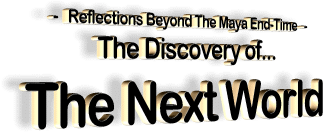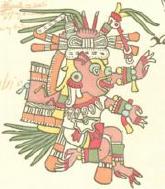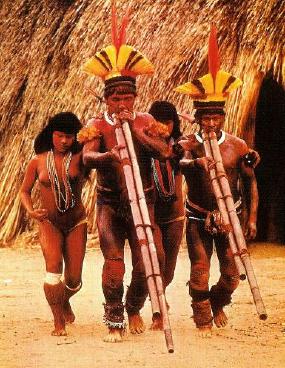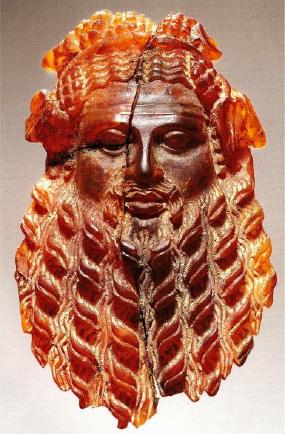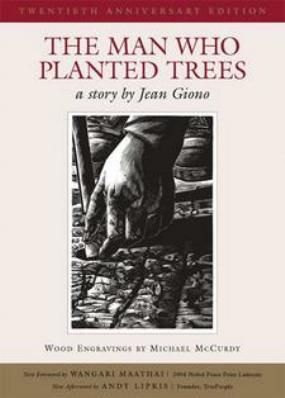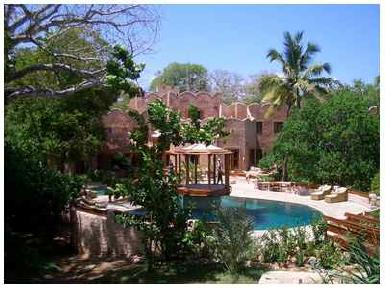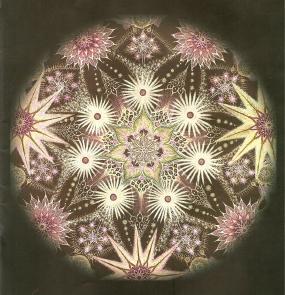|
by John Lash 28 January 2007 Andalucía from MetaHistory Website
Additional to the slim chance that a few
people with guts and intelligence might stand up to intimidation
from the Abrahamic hordes and defy the taboo on critical thinking
about faith issues, as suggested
in the previous article, what other
prospects might we envision for the Maya end-time?
I believe this is the view held by a good many people now writing and talking about 2012, such as Daniel Pinchbeck, but there is also a building expectation of a particular breakthrough tied to the date December 21, 2012.
The progressive transformation underway
might be compared to breaking the sound barrier in a jet: a steady
acceleration up to the specific moment, BAZOOM, when the barrier is
passed. (I went through the sound barrier twice on the Concorde,
which used to level off at a little faster than Mach 2: you don't
feel or hear a thing, but the world outside gets seriously bazoomed!)
For instance, 1821 is the nodal moment of the Romantic movement. Constellated around that moment, before and after, are the key events that defined the movement. A nodal moment signals a vortex in time - a "dissipative structure," to use the odd term proposed by Ilya Prigogine - where the innate evolutionary potential of the human species undergoes review and reworking.
Some potentials (reflected in cultural
tendencies, discoveries, currents of thought and behavior) dissolve
into the vortex, others emerge, simultaneously. Patterns of change
anchored in the nodal moment can be imagined as event-ripples that
spread around the temporal vortex. (Obviously, current ideas of
autopoesis, emergence, and
fractality enter into this analogy, prompting us to consider how
historical patterns might have self-similar and self-ordination
properties.)
From 1993 to 2012 is 19 years. Could this be the period of sensed acceleration?
Perhaps, but I propose a further permutation of the nodal dating: make 1993 the nodal year between 2012, which is 19 years ahead in time, and 1974, which is 19 years back in time. Then we arrive at the interval 1974 - 2012 (with the midpoint at 1992-3, a key pivotal moment) for the acceleration into the Maya end-time.
Readers of Not in His Image may
recall that in the last chapter I trace the co emergence of Gaia
theory, Goddess studies, and the Gnostic revival ahead to today from
around 1974.
The interval is manageable in terms of generational continuity. The experiential lessons accrued by many people in this period of time can be compared and shared by direct interpersonal communication, one generation interfacing with another, without reliance on books, recordings, or other second-hand sources.
This is a huge advantage for plotting
and navigating the slope of the acceleration.
What makes 2012 important is that it has been identified as a sacred date, to be distinguished from mundane calendric time.
Arguelles originally pointed out that we are entrained by the linear scheme of the Gregorian calendar - along with the patriarchal salvationist program attached to it, I might add. Thus he attempted to introduce a 13-moon, 28-day calendar related (he claims) to biological time, as an alternative way to keep track of what we're doing.
Arguelles's calendric reform has been
dismissed as a distortion of Maya calendrics (true), but it has
value by reminding us to reground in lunar and biological timing. A
sacred time-keeping device must incorporate both seasonal and
(human) somatic rhythms, including, of course, the macro-rhythms of
Gaia.
One problem with Maya calendric speculations is that, once 2012 is identified as a sacred date, it is treated as a measure, factored down, permutated, analyzed, etc. I suggested in the previous essay that such computations can draw attention to themselves and away from what we need to discover in the progression to the end-time.
The solution to the Long Count in
historical and experiential terms will not be found in the Count
itself, i.e., in some grand scheme encoded in it, but in the "living
reality" of the eruptions and occlusions of human potential that are
right now constellating around the forward nodal moment, 2012.
It is tempting to jump imaginatively into a prospective stance and make an inventory of all kinds of events and tendencies that reflect the slope of acceleration. To some extent, this appears to be what I am doing here, but not really... To clarify my approach, I propose a metaphor that locates end-time developments within a single, comprehensive frame of reference. That way, rather than merely pile up an inventory of supposed end-time developments, we can each place ourselves in the developing wave.
The language for this metaphor is: the
discovery of Next World, compared to Columbus's discovery of the New
World. But with this qualification: Columbus did not merely discover
the New World, he discovered the native peoples who inhabited it.
Likewise, the discovery of 2012 depends on meeting the natives who
inhabit the Next World, the end-time tribes.
As a mythologist dedicated to translating received myth into existential terms, I like this formulation because it says concisely and precisely all we know about what the Maya themselves must have thought of their calendar cycle: that in 2012 one world would end and another one would begin.
By "world" they understood a world age,
a long-term planetary cycle.
Campbell felt passionately that the transition into the 21th century could be a mythogenetic moment morally and spiritually equivalent to the 12th century, and possibly even resonant with it. I find a lot of veracity in this view.
In Maya-Aztec calendrics, the current world is called Ollin (above) and designated as the Fifth Age or " Fifth Sun."
This is a close equivalent to the Kali Yuga of the Hindus. Not much is said of Ollin except that it will end with "movement," possibly meaning earthquakes, crustal shift of the earth's mantle, collapse of ice sheets, rising of sea levels, etc.
Ollin also means "shift of consciousness, mind movement."
Curiously, this glyph recalls intertwining strands of DNA, with the three-prong, four-notch motif suggestive of three-letter codons composed of four bases. Okay, so tell me I'm fabulating, but perhaps not. One of the several mysterious features of DNA is the shifting of histones, the chief proteins in the chromatin that act as spools around which DNA winds, keeping genes in place. In effect, histones lock or seal the genetic code, and when they move, they unseal it.
This biochemical action is the
equivalent to the mythological concept of the apocalypse, "the
lifting of the seal." The apocalyptic moment when histones shift
cannot be determined, because biologists are uncertain what makes
histones shift. Could histone-shift happen massively for the human
species at a particular moment - say, due to the traumatic impact of
massive life-threatening events? No one knows, but it cannot be
ruled out.
Which sounds pretty damn relevant, I'd say.
The allusion to Xolotl (Sho-LOW-tul) is
telling. He is the twin or double of Quetzalcoatl, the mythological
figure most often associated with the Maya end-time. Xolotl is the
evening star (Venus, appearing after sunset), the Lord of the West,
a shapeshifter - that is to say, a sorcerer and master of occult
powers, siddhis. I will return to this theme at the close of this
article. (Right, Xolotl from the Codex Borbonicus.)
Each such mythogenetic moment holds in
solution a constellation of powerful choices, but the magic of the
moment only becomes real when these choices are actually defined and
made, one person at a time. Following the metaphor I've proposed,
the essential choice we each face on the accelerating approach to
2012 could be stated like this:
If some readers are now on board and find the language in use acceptable, how about we expand the guiding metaphor?
To paraphrase Paz,
These discoveries are all of one kind: social, interpersonal, and intimate meetings between people, members of tribes who recognize each other. To foster this recognition, it would be helpful to have a tentative sketch of the tribes.
I characterize them by these names: the
Originals, the Orgiastics, the Sustainers, the Evolvers, and the
Visioneers.
Ceremonial dancers
Kamiura tribe, Xingu
River, Brazil The Originals are the first peoples of the earth, or what's left of them.
They live in reflective symbiosis with the places where they live, which gives them a special grounding power. At the same time, they are vulnerable to being uprooted and displaced by predatory societies driven by the double ideology of conquest and entitlement.
Members of such societies believe that
the planet belongs to them, materially, and they have an entitlement
to claim it by force from any peoples who may be inconveniently
sitting on resources they would like to possess for themselves.
Their sense of entitlement is enforced by the belief that they are
made in the image of a paternal deity who gives them permission to
breed like lice and dominate the earth.
For the Originals, their way of life is
rooted in the earth, framed by the stars, linked to plants and
animals, nurtured by past generations and consecrated to future
ones. Take all that away and some people will choose to die rather
than accept the alternatives that "civilization" proposes to them:
the San Bushman woman I quote in
Tree and Well, for instance. She is
an Original.
Years, ago, when I first spoke at the Marion Institute, I proposed in the spirit of reviving the Mysteries that each person adopt an indigenous tribe and an endangered animal. The Originals and the animals come together, and they may disappear together.
Upon signing a treaty with European settlers in 1854,
Animals, birds, fishes, and insects, also belong to the tribe of Originals.
Most indigenous peoples around the world recognize the four-leggeds, the crawlies, and other species as kin to us, with no less dignity and intelligence, and no less value for the earth. Meeting blue whales, white lions, dolphins, scorpions, spotted owls and Andalucian golden eagles, is essential to discovering the Next World. The recognitions that shape the world ahead will have to be profoundly rooted in the all-species connection.
Those who champion this connection
belong to the tribe of the Originals.
Amber mask of Dionysos
Roman, 1st Century This tribe is a kind of distant reflection of the Originals, or perhaps a forward projection in evolutionary terms.
It consists of a huge spectrum of "urban tribes," the diverse community of younger people who share a clan sense of identity and a common spirit of celebration; the followings of Burning Man and the Rainbow Tribe, for instance.
There are thousands of clans within the
Orgiastic tribe, some of them consisting of no more than two or
three members. Many of them use the Internet to organize their
activities and keep communication up and running, yet they stand
apart from the cybernetic community as such by their pronounced
affinity for the natural world and native-mind peoples, the
Originals.
Nothing happens on the Internet, which is an electronic grid dependent on wired-off acres of blinking consoles in featureless concrete warehouses, but it a great medium for announcing things that happen, and even generating the "buzz" that makes them happen.
Many Orgiastics are inclined to chemical
highs and the vacant cybernetic ideologies that come with it, but
they are essentially organophiles and nature-lovers, and as such,
they ought not be confounded with the segment of the younger
generation that does not know where eggs come from (which is,
according to a recent study in France, sixty percent of the twenty-somethings
surveyed).
The Greek orgia means "operation, working." In the Mysteries, orgies were group events like collaborative seminars in which members worked together on certain projects. Sometimes, but not always, orgies had a sexual component. But even when they did, sexual activity was not merely hedonistic. Rather, it was more like a group Tantric session intended to raise and fine tune somatic, emotive, and cognitive intensity.
Members of the Orgiastic tribe share an innate longing to revive this kind of communal synergy, and connect through it to the body of the earth and the cosmos at large. Hence, they are prone to trance and dance, celebrating the Dionysian arts of music and mime, not to mention divine mania.
Even when they do this in an urban
setting, surrounded by the blast and blare of electronic gimmickry
in total oblivion to natural conditions, their inborn ritual rapture
reprises the ecstatic celebrations that were originally enacted free
of the electronic setting and the urban venue.
Foundation text for
the sustainability movement This tribe shares with the Orgiastics a primary orientation to group effort and the pleasures of the natural world, but they enact it in a more conservative manner.
The movement for sustainable living is the brainchild of the Sustainers. Much of what they do overlaps with the Orgiastics who, like them, look to primitive and indigenous peoples to model the future. Members of the Sustainer tribe tend to be homebodies, attached to creature comforts, focused on self-reliance and socioeconomic independence.
They network a great deal, but for the
purpose of implementing specific programs and plans rather than to
party.
If you have the spirit and outlook of a Sustainer, it makes no sense to stake your life on something that is unsustainable. This tribe contains the true survivalists whose knowledge of natural ways will be indispensable to founding the end-time communities.
The ecomimicry of Jeanine Benyus
represents the focal point of the Sustainers' mission, the tip of
their visionary arrow.
They are forever collecting and disseminating information on,
...and proposing innovative ways to create a sustainable society.
Their role in the five-tribe world is sober, stable, and generationally based, by contrast to the free-form hedonism and teepee-style living of the Orgiastics.
The Marion Institute, which sponsors this site, exemplifies the mission of the Sustainers, combining visionary and practical elements into a futuristic world view with a focus on "connecting for change." Some of its projects offer service to the Originals, such as Mangari Maathai, winner of the 2004 Nobel Peace Prize, who founded the Greenbelt Movement. Planting trees is a Sustainer ritual - performed, in her case, by an Original.
The Institute's support of Jeremy Narby's Nouvelle Planete, a program to establish the legal claim of
the indigenous peoples of the Amazon to their native plants and
medicinal knowledge, is another good example of Sustainer-Original
crossover.
Nomad, an ecotourist
lodge on the south coast of Kenya This tribe shares many of the characteristics of the Sustainers, with one crucial difference: Evolvers work within the System, seeking to improve it rather than create something else, something better than the System.
The Natural Capital Institute founded by Paul Hawken, which promulgates methods and models for socially responsible investment, is typical of this tribe. The Marion Institute also supports the NCI, so TMI is actually a hybrid organization, inspired equally by Sustainer and Evolver incentives.
This coordinative or balancing role in
end-time projects is reflected in the fact that the Marion Institute
was founded in 1992 at the pivotal node of the 1972 - 2012 interval.
What is sustainable has merit in the way it sustains itself: it does not have to "grow" economically. There is an ideological divide between the tribes here, for sure, but (let's hope) no cause for intertribal warfare. As long as the current economic system does not fall into total chaos, there will always be opportunities for to Evolvers to work of benevolent forms of capitalism and planet-friendly free enterprise.
At the same time, in parallel efforts,
the Sustainers will be working with other models that do not depend
on economic return.
In many instances, Originals or their descendents are employed to feed, lodge, guide, and entertain ecotourists, allowing the natives to live a double life, working in the System yet free to maintain their ways of life independent of it as well. Ecotourism is not a perfect thing, but it's a great challenge for Evolvers who believe in benevolent capitalism.
Given that the entire economy of certain regions of the planet depends on tourism, it may be the leading edge of the Evolver tribe's global outreach, an optimal place for them to center their efforts.
Sustainers, by contrast, are more likely
to be stay-at-home types. Orgiastics, who are unlikely to be able to
afford the price of ecotourist package deals, to make life itself
into a grand touristic adventure.
The aim of the Evolver project is to promote,
The new planetary culture so envisioned is a not an educational and cultural venture, it is new phase of planetary commerce, far more sophisticated than anything that emerged from the hippie movement of the 1960s.
If Evolvers have true entrepreneurial
flair, there is a great deal they can do to make the current
economic picture more human and innovative, with a reduced
ecological footprint.
But all tribes would agree, I believe,
that we as a species will view survival (i.e., food, water, clothing
and shelter, if you need to be reminded) more wisely, and have a
better chance of achieving it, if we do not make it a for-profit
venture.
"Elfstar"
by Rebekah Bovey-LeBuillou The mark of the Visioneers is, obviously, their visionary capacity, their talent to frame the grand overview and propose models that help all the tribes to navigate the evolutionary bend of the end-time.
Originally bring to the modern world various visionary systems of ancient provenance, such as the glorious sky-serpent cosmology of the Desana of the Northwest Amazon. (See Amazonian Cosmos by Gerardo Reichel-Dolmatoff.) I cite this vision in my book on astral phylogenetics, Quest for the Zodiac, explaining how the sky-serpent-brain motif of Desana cosmology triggered a profound insight that allowed me to decode the stellar writing.
The song-lines of the Australian
Aborigines present another example of Visioneer tribe legacy that
can enrich our self-knowledge as a species, and assist us to devise
our evolutionary niche. Members of this tribe hold the long view of
human experience.
The interactive model of Gaian planetary
symbiosis is far from finished. I would say that we are only at the
elementary stage of defining it. As the vision unfolds through the
collaboration of many people, we are challenged to become discerning
and selective, able to choose wisely among those visionary models
that contribute to Gaia theory, perhaps even enhance and deepen it,
and those which do not.
Although Teilhard rejected the literal interpretation of Genesis, he retained the religious belief that Jesus Christ somehow embodied or focalized the fullness of human potential and holds the Omega Point until humanity can advance to it. This Christocentric view strongly recalls the teachings of Rudolf Steiner (1875 - 1925), the Austrian philosopher and founder of Anthroposophy, who regarded Jesus Christ as the "representative of mankind."
The works of Steiner and Teilhard exemplify what I call totalist male-mind models in which feminine, ecofeminist, or Sophianic aspects of cosmology are downplayed, if not entirely absent. The vast scope of such visionary scenarios appeals to many people, despite these (to me) serious shortcomings.
Some leading voices in the
counterculture find in Teilhard's noosphere a prefiguration of the
Internet as a global collective mind in cyberspace.
Obviously, the list is paltry.
Today it could be expended by a factor of ten. It would have to include everything from Terence McKenna's timewave (also closely linked to 2012 calendrics) to Irving Lazlo's connectivity hypothesis, and on and on.
Ken Wilbur, who is by now
regarded as the tenured dean of Visioneers, would have to be
included. I only include him to admit that I exclude him. I can't
read Ken Wilbur., nor can I get my head around a great many of these
grandiose schemes.
I am also in diametrical disagreement
with Hubbard's view, shared by many others, that the human species
is the glory-crowned animal at the growing point of millions of
years of cosmic evolution. I don't believe that self-consciousness
in our species is a great achievement, toward which all of nature
have been laboring for untold eons. I am more inclined to view it as
our worse handicap, the ego hang-up of an wounded animal that has
lost its way.
It is a legacy I have recovered and restored. I would not place myself in the Visioneer tribe, but among the Sustainers, in the clan of deep ecology. I have not developed a cosmic evolutionary scheme of vast scope and detail. That's not been my calling in this life, although for a long time I thought it was. Because I worked in astrology and naked-eye astronomy, I thought that I was a cosmologist, an originator, but it would be more accurate to say that I am a teacher of cosmology and a consumer advocate of cosmologies.
I assess and critique the master
schemes, but I do not offer one of my own. (The system of astral
phylogenetics I present in Quest for the Zodiac is not a
cosmological scheme, it is a cosmographic method, a way of decoding
the endowment of an individual out of the genomic potential of the
species.)
At bioneers the five tribes converge, and members of the Visioneer tribe are often invited to give plenary talks, providing a sense of holistic orientation for a vast diversity of projects and programs. Clearing houses such as Esalen, the Noetic Institute, Omega, Hollyhock, also provide platforms for Visioneers to hold the talking stick.
The biomimicry of Jeanine Benyus is an offering from the Sustainers to the Visioneers, a savory evolutionary potlatch. I would probably place Terence McKenna among the Orgiastics, but he is known for his Visioneer-like modeling genius. Members of the Visioneers tribe include not only those who produce the defining visions and cosmic scenarios, but also those who embrace and propagate them.
The cosmic model of Brian Swimme,
"The Story of the Universe," has spawned an entire movement in which
other people spread the evolutionary myth that Swimme initially
articulated.
Many other examples could be cited (The Nature Conservancy, for instance.)
I have certainly overlooked some of the
more obvious and vivid. It would be fun to make an inventory of
tribal activities. Any volunteers?
As Thoreau noted at Walden Pond, the
great adventure of each day, which we each share with the sun, is to
make the day.
Among the activities that are getting close to their expiration date, I would place new age spirituality. Many of you who are reading this article to the end might think that new age spirituality, in some respects, at least, points the way to the end-time and what's possible in the coming shift, but I would suggest another view.
I sense that much that passes for spirituality today will be shed rapidly as we enter a time when real spiritual trials, formidable tests of intent and imagination, are forced upon us, individually and collectively.
With the acceleration toward 2012, the
game may be expiring for new age pretensions and empowerment regimes
such as come under the catch-all term, "shamanism."
I have been following the New Age from its inception out of the Psychedelic Revolution of the 1960s. I wrote a critical guidebook to the phenomenon of alternative spirituality, a rather naive work, but useful nonetheless. I do not say casually that new age spirituality is expiring. I say it with a sober view toward how transformation comes out of death, when an impulse is genuine and rooted in the evolutionary potential of humankind.
By this I mean that all that has been so
far categorized as new age spirituality may have been, up to now,
the mere husk of a deeper, richer fruit. The New Age, fraught with
so much pretending and false pretence, so much phoniness and
disguised narcissism, will have served its purpose well if now it
leads to something truly genuine that transcends it.
|
